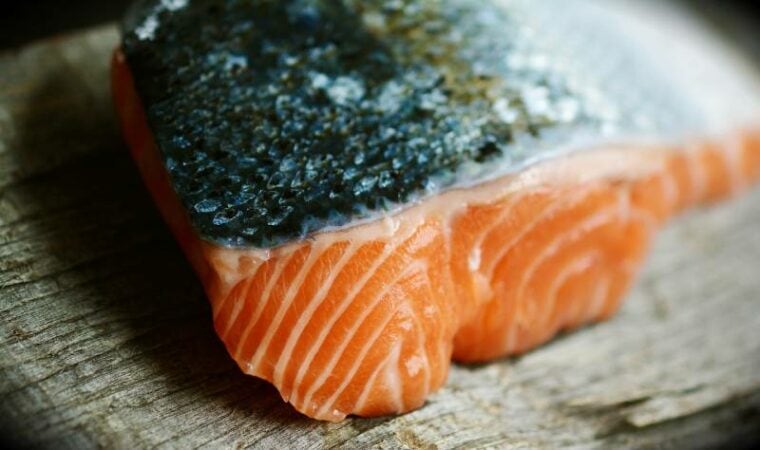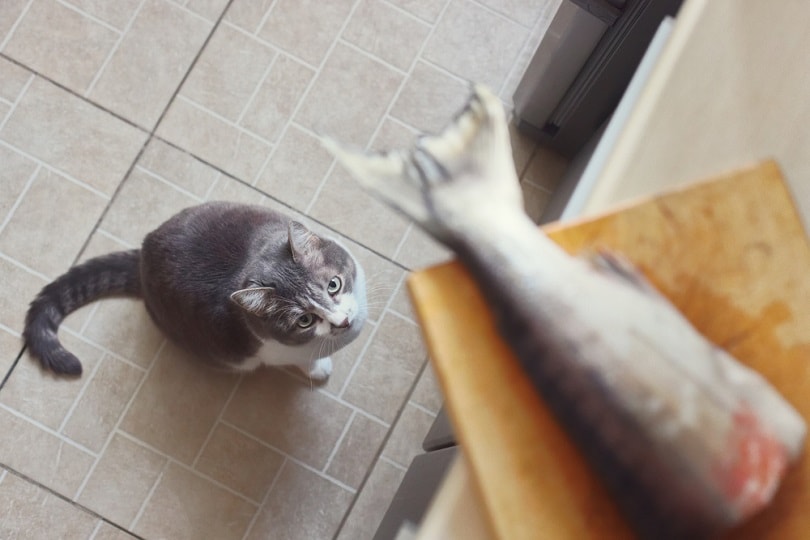
Salmon is typically healthy for cats since it contains omega-3 fatty acids, proteins, and other nutrients. However, like any other food, you should feed salmon to your cat in moderation.
You should also know how to prepare salmon properly so that it is safe for your cat to consume. In this guide, we will explain the benefits of salmon and discuss the step-by-step process of cooking it for your feline friend.
How Much Salmon Should You Feed Your Cat?
On average, a 10-pound cat should consume 270 to 290 calories per day. Vets also say that treats should only make up 10% of this daily intake. According to the USDA, a 396-gram fillet of raw wild-caught salmon has 562 calories, which means on average, salmon’s caloric content is 1.4 calories per gram.
Based on daily caloric intake calculations, you should feed your cat only a small piece of salmon, about 2 oz., per day. However, since salmon is a protein- and species-appropriate food, you could safely increase the cat’s allowance to 20% of its daily calories, which will be around 4 oz. of salmon. This should only be done on occasion, though, and not on a daily basis. If you do this, you should remember to remove some of your cat’s regular food to avoid overfeeding and prevent weight gain.

Nutritional Profile of Salmon
Salmon’s nutritional profile differs among varieties. For instance, wild-caught salmon is higher in protein, while farmed salmon is rich in calories and fats. However, all salmon varieties contain the same key nutrients, including proteins, fat, vitamin B12, and vitamin B6.
Per the United States Department of Agriculture (USDA), a 3-ounce (85 g) serving of wild Atlantic salmon contains the following nutrients:1
| Calories: | 121 |
| Fat: | 5.4 g |
| Fiber: | 0 g |
| Sugars: | 0 g |
| Protein: | 17 g |
| Sodium: | 37.4 mg |
| Calcium: | 10 mg |
| Iron: | 0.7 mg |
| Vitamin B12: | 2.7 µg |
| Total Saturated Fatty Acids: | 0.83 g |
| Carbohydrates: | 0 g |
Benefits of Salmon for Cats
A 3.5-ounce farmed salmon portion has 2.3 grams of omega-3 fatty acids, whereas wild salmon has 2.5 grams of these long-chain fatty acids. These fatty acids support cardiovascular health in cats, soothe dry and flaky skin, slow kidney disease progression, and lubricate arthritic joints in older cats.
Salmon is also a rich source of protein, which has plenty of functions inside a cat’s body. Proteins play a role in bone health, maintaining muscle mass, and healing after injuries. Cats are obligate carnivores, so they need animal protein sources in their diets.2
Like proteins, salmon also contains B vitamins, including B1, B2, B3, B5, B6, and, B9. These vitamins enhance your cat’s metabolic functions and play an active role in energy production.

Is Raw Salmon Safe for Cats?
Although cats can eat raw salmon, you should avoid feeding raw fish to your pet to prevent possible health issues. The presence of Neorickettsia helminthoeca bacteria that might be present in a parasite fluke often found in salmon is responsible for making dogs sick when they eat raw salmon. While cats are notably resistant to this bacteria, it’s still not entirely safe to serve uncooked salmon to a cat.
It is never recommended to feed raw salmon or any raw fish to your cat. This is due to the potential risk of food poisoning and the fact that some fish species contain an enzyme that destroys thiamine, which is inactivated once the fish is cooked. While salmon is not one of the fish species containing thiaminases, the risk of food poisoning alone is enough to recommend against feeding raw salmon to your cat.
If purchasing canned salmon for your cat, you should keep in mind that many of these varieties include spices and additives that might upset your pet’s stomach or even be toxic. Canned salmon in oil is not recommended because it increases the overall fat content. Read the can’s label carefully; canned salmon in plain water or brine might be safe for your cat as long as it does not contain other spices. If in doubt, consult with your veterinarian.
You might want to give fish oil supplements containing salmon to your cat. While these supplements are generally healthy for cats, it’s best to check with your vet beforehand.
How to Cook Salmon for Cats
The best and safest way to feed salmon to your cat is to cook it. Here’s an easy recipe to whip up some dinner for your pet:
Step 1: Boil the Water
Put the water in a medium-sized pan and boil it over high heat. Add the grated veggies to the pot. Stir the ingredients and put the salmon filet on top of the veggie mix.
Step 2: Cook the Salmon
Cover the pan with a lid and cook for 10 minutes until the salmon is cooked thoroughly and the vegetables become soft. Remove the pan from the heat and let it cool.
Step 3: Break the Salmon
Once the mixture has cooled, break the fish into smaller chunks, removing any bones. If the salmon filets have skin on, cut it into small pieces too. The skin is richer in omega-3 fatty acids compared to the fish itself, so make sure you return it to the pan.
Your cat’s dinner is ready! Just remember to feed them small amounts in moderation.
Other Easy Salmon Recipes for Cats
The method mentioned above is the simplest way to cook salmon for your cat, but you can make different variations of this recipe or salmon treats to make sure your kitty doesn’t get bored.
These recipes have been approved by a veterinarian because they include only cat-friendly ingredients, however, some of these recipes are not complete and balanced diets to feed your cat on a daily basis. These recipes are a great add-on to your cat’s diet. They are only meant to be fed on occasion and not as a regular staple diet. Please consult your veterinarian to help you decide what is the best diet for your cat.

Salmon & Egg Mix
The salmon recipe is quick to make, taking around 20 minutes of prep time.
The recipe makes several servings. Its totality contains 415 calories, 16 grams of fat, 62 grams of protein, and 3 grams of carbohydrates. Here’s how to make it:
You can feed salmon to your cat in small servings, and remember to calculate the calorie allowance. Store the leftovers in the refrigerator in an airtight container. It will last for 3 days if refrigerated and up to 3 months if frozen.
Gourmet Salmon Patties
Your cat deserves a treat every once in a while, and this recipe is the best for such times. Do not feed this recipe to your cats on a daily basis, oats are a source of fiber but also not ideal to feed cats regularly as they are high in carbohydrates.
Before preparing this recipe, preheat your oven to 350 degrees Fahrenheit. Now, do the following:
Salmon Cat Treats
If you don’t mind using a few extra ingredients, you can make these salmon treats at home.
Heat the oven to 350 degrees Fahrenheit and mix all ingredients in a bowl minus the flour. Once everything else is mixed, add the flour slowly and stir well with each addition. Here are the next steps:
Since this recipe makes a big batch, you can either trim the recipe per your cat’s daily caloric intake or wrap the remaining dough and freeze it in an airtight container.
Tips for Picking Salmon for Cats
You should avoid buying farm-raised varieties when shopping for salmon for your pet. Most farm-raised fish are exposed to high concentrations of toxins, antibiotics, and pollutants. Instead, opt for wild-caught varieties. They are more nutritious and contain fewer toxins. Also, check the label before buying to ensure the salmon is completely free of preservatives and fillers.
Knowing exactly what your feline companion can and cannot eat will help you become the best pet parent. Recognizing that not all cat bowls are equal is also key! The Hepper NomNom Cat Bowl sets itself apart from traditional options by catering to the specific needs of cats. The innovative design offers whisker relief via shallow dishes and promotes digestion with a slight bowl elevation. Find out if the Hepper NomNom is right for your cat by clicking here.
At Pet Keen, we’ve admired Hepper for many years and decided to take a controlling ownership interest so that we could benefit from the outstanding designs of this cool cat company!
Conclusion
Cats are carnivores, so it shouldn’t come as a surprise that they like salmon. The good news is that salmon is also rich in beneficial nutrients. So, it’s a win-win.
But preparing salmon the right way is vital to ensuring your pet’s health and safety. Avoid giving raw or smoked salmon to your cat, and, instead, cook the fish properly. You can follow one or more recipes in this guide to ensure your kitty gets its daily dose of healthy food.
Featured Image Credit: congerdesign, Pixabay








